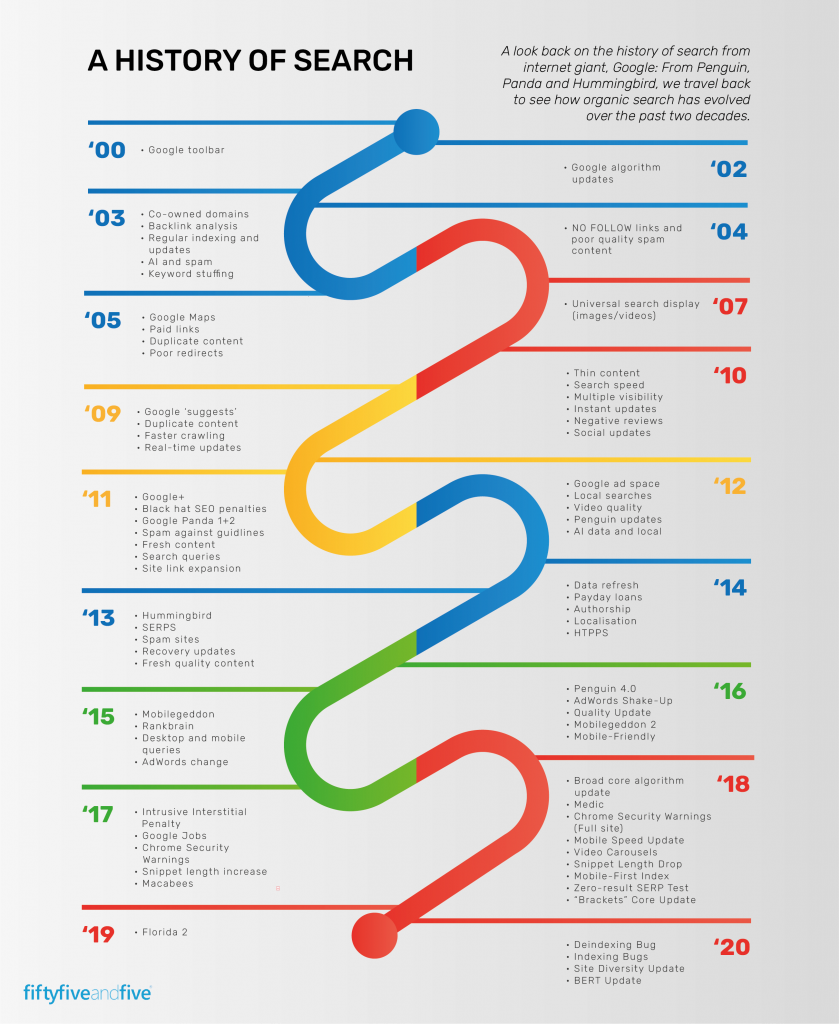For many websites, organic traffic represents over half of their visitor volume. What’s scary, however, is that any company could lose the value of months (or even years) of consistent and diligent SEO work in mere seconds. The main culprit? Not resolving SEO issues in a timely manner. As companies and web traffic grow, it’s easy to ignore small SEO issues and add them to the ‘to-do’ list. Those SEO ‘to-dos,’ however, add up and can cause skyrocketing bounce rates and free-falling traffic. As a marketing data analytics firm, we’ve assisted countless companies with their SEO issues, helping to prevent ranking, conversion, and sales losses.
Google Search Console
As a content marketing analytics company, we rely heavily on Google Search Console, as it reveals so much of what’s going on with your site’s traffic. Given that it is such an incredibly powerful tool, it can be overwhelming to know what to look for without help from a marketing data analytics firm. Here are a few things you can find in Google Search Console that are invaluable for troubleshooting your organic search traffic:
- Site errors and warnings
- Search queries that help your site appear in search results
- A list of internal and external pages that link to your website
- Crawl rate and when Google accesses your site
Although not comprehensive, these metrics are a fantastic first step to properly diagnosing any organic search issues you might be having. If your car breaks down, the first place you would look is under the hood. If your organic traffic begins to break down, the first place you should look is Google Search Console.

Algorithm Changes
Every year, Google changes its algorithm over 600 times. Needless to say, it can be difficult to keep track of every change. As a marketing data analytics firm, we understand how important it is to keep track of each and every iteration, as it makes it possible to determine what changes you need to make and when. There are plenty of resources – like Moz, Search Engine Journal, and more – you can use to learn how changes will impact what Google is penalizing, why Google is making changes, and how you can stay on Google’s good side. If you begin to see a decline in your search traffic, you should review these resources to ensure your website is compliant with Google’s policies.

Quality of Content
As a key focal point for Google’s algorithm, they have worked to prevent low-quality and thin content from appearing in search results. In short, search engines work to provide the results that best match the search intent of a user. If you want to rank highly, you have to convince search engines you’re answering the questions of users. With that, we live by a simple principle when it comes to organic search traffic: Content Is King. Ensure the content you are posting answers prospect’s questions, utilizes strong H1s and H2s, leverages strong supporting imagery (don’t forget alt. text!), and isn’t stuffed with unnecessary keywords.
Inbound Linking
Having inbound links is one of the most valuable ways to signal to Google that your website is high-quality and authoritative. In short, an inbound link is a link from another website to yours. Although highly valued in Google’s organic search algorithm, the tricky part about inbound links is that you have very little direct control over them. Should you see a decline in your organic and/or referral traffic, using link checkers like Smallseotools and majestic is a great way to determine if there has been an inbound link decline for your website. If this is the case, a couple of ways you can strengthen your inbound linking strategy is by writing guest posts on websites and creating valuable original content that other writers can use.

Sudden drops in any traffic channel are scary. Given that organic traffic is composed of high-intent users, it can be even more concerning, as it means fewer conversions and revenue. Should this ever happen to you, avoid panicking. At the end of the day, it’ll likely be something easily identifiable and can be remedied quickly in-house or with the help of a marketing data analytics firm.
Interested in working with a content marketing analytics company to help troubleshoot your organic search traffic? Contact Us!
Whether you are starting up a small blog or running the online presence of a multinational enterprise, analyzing, managing, and understanding website traffic data is crucial to the success of your business. From the perspective of a digital marketing agency, Google Analytics is one of the most powerful and accessible tools out there, with the wealth of free information that it offers. However, with all of that data at your fingertips, it can be easy to feel overwhelmed. Even if you know where to start, you may not be aware of all the many features available, or just how deep you can dig.
Over the years, Bluetext has learned several useful Google Analytics tips and tricks that have allowed us to glean even more valuable business insights for ourselves and our clients. Here are four easy ways you can do the same and dive deeper into your Google Analytics:
1. Automate Reporting Notifications/Set Up Custom Alerts
By default, Google Analytics will notify you of any unusual site activity. However, you can set up your own custom alerts so you don’t have to rely on Google to tell you when something important happens. Custom Alerts is a feature in Google Analytics that allows you to set custom parameters to monitor for unusual site activity and track changes in the metrics that are most meaningful to your business. Once configured, you can opt-in to have Google send you an email notification if a change triggers one of your custom alerts. What may be considered unusual? Say, for example, your site experiences a 200% increase in traffic on a given day. This initially sounds great, but be wary, this could be a bot attack!. If you have Custom Alerts set to notify you for traffic increases of higher than 50% in a day, Google Analytics would record the data surrounding this event and alert you to it.

While it can be tempting to create dozens of alerts to cover every possible anomaly in your traffic, you should focus on tracking information that is most closely related to your business’ top priorities and signals events on which decision-makers are likely to take action. Custom Alerts can be set up to monitor and notify you of things like:
- Analytics Flatlining
- Traffic Drops or Drops in Organic Traffic
- Increases in Referral Traffic/Conversions from Syndicated Content
- Drops or Spikes in Goal Completions
This is an extremely useful tool, because while automated notifications should never be a replacement for regular review of your KPI-based reports, Custom Alerts can assist you by proactively identifying any issues or opportunities, including those you may have missed otherwise.
2. Create Custom and Advanced Visitor Segments
Custom segments are a powerful tool that allow you to dive deeper into your audiences and create reports within reports to gain information about how specific users are interacting on your site. Custom segmentation filters traffic based on particularly chosen criteria including dimensions or metrics, visit date, location, and more, so you can compare the performance and behavior of specific segments to the rest of your users. When implemented this can be used to gain valuable insight into how certain types of visitors behave in comparison to one another, rather than forcing you to make do with a broad overview of all pageviews or sessions.
There are many possible applications of custom segmentation, including:
- Tracking very specific groups of visitors, like male users aged 18-35 who have a strong interest in financial services, visited your site from a mobile device and are located in a particular region
- Identifying high-value customers by filtering for visitors within your target demographic whose sessions lead to a conversion
- Evaluating the performance of a given marketing campaign by identifying new users who that spent more than 20 seconds on your site during a specific time frame

Taking the guesswork out of the equation, custom segments enable you to gain valuable business insights and understand core audiences in a more robust way.
3. Utilize Annotations in your Custom Dashboards and Reports
Google Analytics allows you to create custom dashboards and reports so you can quickly access the most valuable data and focus on the KPIs that are most pertinent to your business goals. These dashboards display critical information as they are specifically designed for your needs. However, perhaps you aren’t the only person responsible for looking at these custom dashboards and reports. Maybe you understand the reasons behind any spikes, drops, and other unusual events that appear in your reports, but need a way to keep tabs on why these things happened when. Enter: annotations.
Annotations are simple notes that appear as speech bubble icons along the bottom of an Analytics graph. They can be added by clicking the downward arrow tab icon immediately beneath the graph and then “+Create new annotation”. Aside from recording the note, annotations can also document the date created, the author’s email and be set to “Private” or “Shared” to control who can view the annotation.
 Whether you’re sharing a report with relevant stakeholders and need to explain a certain fluctuation in traffic, need to be reminded of when a content update was made when returning to a graph weeks later, or want make other account managers aware of a promotional campaign that launched on a given day, annotations are a great way to communicate anything of note directly within Analytics.
Whether you’re sharing a report with relevant stakeholders and need to explain a certain fluctuation in traffic, need to be reminded of when a content update was made when returning to a graph weeks later, or want make other account managers aware of a promotional campaign that launched on a given day, annotations are a great way to communicate anything of note directly within Analytics.
4. Analyze Behavior Flows to Optimize UX
One of the best ways to improve your user experience is to gain a deep understanding of how your users behave. How are they moving around your site? What pages do they visit, and in what order? Where are they coming from and when are they exiting? Where and when do they convert or drop out of the funnel? Answering these questions can help you discover potential opportunities or problem areas in the user journey, so that you can then prioritize and address them to optimize the user experience. Lucky for you, using Behavior Flow in Google Analytics can help you do just that.

The Behavior Flow report visualizes the path a user follows from one page to the next or from one event to another. This report can give you insights on:
- The most common routes visitors take to get in and out of specific pages
- Pages that are bridges or areas of the site that are conversion hubs
- What content keeps users engaged with your site
- Potential content issues, confusing navigation, or misleading design
- If users are leaving the site when you want them to, like from a “Thank you” page, or right before they convert, indicating a poor customer journey
Additionally, by comparing Behavior Flows to Event tracking- which allows you to track anything and everything that a visitor or a user can click on like CTA buttons, downloadable items, ads or pop-up interactions- you can get a visualization of what within a user flow catches user attention, or not. Analyzing user behavior through Behavior Flows and other means will not only help to improve and optimize the user experience, but produce logical, easy steps that will encourage users towards conversions.
Conclusion
The possibilities are endless when it comes to Google Analytics. The real question is though, how can your business best analyze the data and turn it into actionable intelligence. Enter: a marketing analytics agency, such as Bluetext. A marketing analytics partner will help set up these custom dashboards, pinpoint the key metrics to pay attention to, and help set goals to reach your overall business objectives. Interested in seeing what Google Analytics insights can do for your business? Contact us today.
Marketing, unfortunately, isn’t an exact science. Nor is there ever a “one size fits all” solution to business objectives. There are hundreds of best practices when it comes to marketing, but sometimes those best practices aren’t the best fit for the goals you’re looking to achieve. To make sure you’re driving the strongest results, you need to test! You can’t optimize for the best results for what you don’t test.
At Bluetext, we are big advocates of A/B testing; we use the tactic across different marketing initiatives – from landing pages, email templates, call-to-actions, banner ads, and everything in between. And by hiring a marketing analytics agency, you can eliminate the guesswork around what tactics are the best fit for your business needs.

What is A/B Testing?
A/B Testing (also known as split testing) is a simple and effective tactic to use when you want to understand your audience better and improve overall campaign performance. A/B testing is an experiment where two (or more) variants of a specific asset are shown to users at random, and statistics help to determine which variant performs better for achieving your ultimate goal. Users start off with a control asset, and then run a variant alongside the control, measuring results accordingly. Sound familiar? It’s the exact same concept of scientific method you learned in primary school! The only difference is you can turn these stats into real business revenue, not a lab report.
A/B testing takes the assumptions and the ‘best practices’ out of the equation. Marketing, as we mentioned, isn’t an exact science; we don’t know what we don’t know! A/B testing relies on statistical data to help marketers understand and verify what resonates best with their audience.

How A/B Testing Works
A/B testing can be executed in several ways. If you’re running a display ad campaign and want to test animated ads vs. static ads, then perhaps you don’t necessarily have a ‘control.’ You launch both variants at the same time, and once you collect enough data for the test to be statistically significant, you pause the under-performing ad variant.
Alternatively, you may want to improve your landing page conversion rates. In this case, you take your current landing page environment – the control – and change one asset on the landing page; this page becomes your variant. The popular heatmapping landing page tool, Crazy Egg, notes that A/B testing landing pages is useful because it “lets you see what elements really click with your audience and which don’t. Changing just one word in your CTA can reveal nuances about your target audience that you never would have otherwise discovered.”
After your test has reached statistical significance, you have the tools needed to determine whether you should continue to keep your control landing page live, or if you should redirect all traffic to your new landing page.
The most beneficial aspect of A/B testing is that you will receive results: you will end an A/B test with a clear winner, and insights into what resonates more with your audience, arming you with the tools you need to improve your marketing performance.

You Have A Winner! Now What?
Once your test has run its course by reaching statistical significance, and you have a clear winner, what’s next?
Implementation to start! Don’t waste any more time – or money – driving users to a lower-converting landing page, or showing underperforming ads to your audience. Take the winner of your A/B test, apply it, and start to see your KPIs skyrocket.
Of course, testing is a marathon, not a sprint. Just because you tested one asset, there are still hundreds – thousands – of other tests you could (and should) run. A/B testing should be an ongoing tactic for your marketing efforts, not a one-and-done completion. Remember: you can’t optimize what you don’t test.
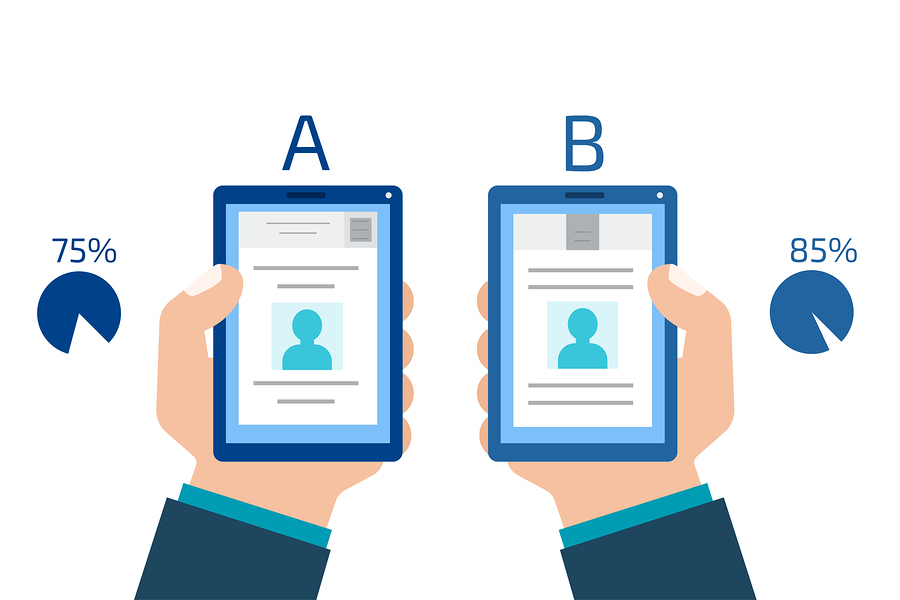
When determining what your next A/B test should be, make sure you’ve analyzed your most recent test, and understand why the winner actually won. What did you learn? Did a new call-to-action boost conversion rate? What did you change in your CTA, and why do you think that minor change helped to increase your conversion rate? If the CTA on that landing page helped to increase conversions, where else could you apply this change?
It’s critical to take time to ask yourself these small questions to help understand the bigger picture. Chances are, you will come away from your latest test analysis understanding your target audience even better, and will have an idea for your next big A/B test.
One thing we can’t stress enough: document your A/B tests! Document the setup, the control and variant, the winner, your analysis – everything. Save it in a safe place. As Medium states, documenting your tests “leads to deeper understanding and context. In turn, that understanding sparks new ideas causes stronger hypotheses, and prevents running similar tests twice.” You will absolutely want to reference previous A/B test documents before jumping into the next!
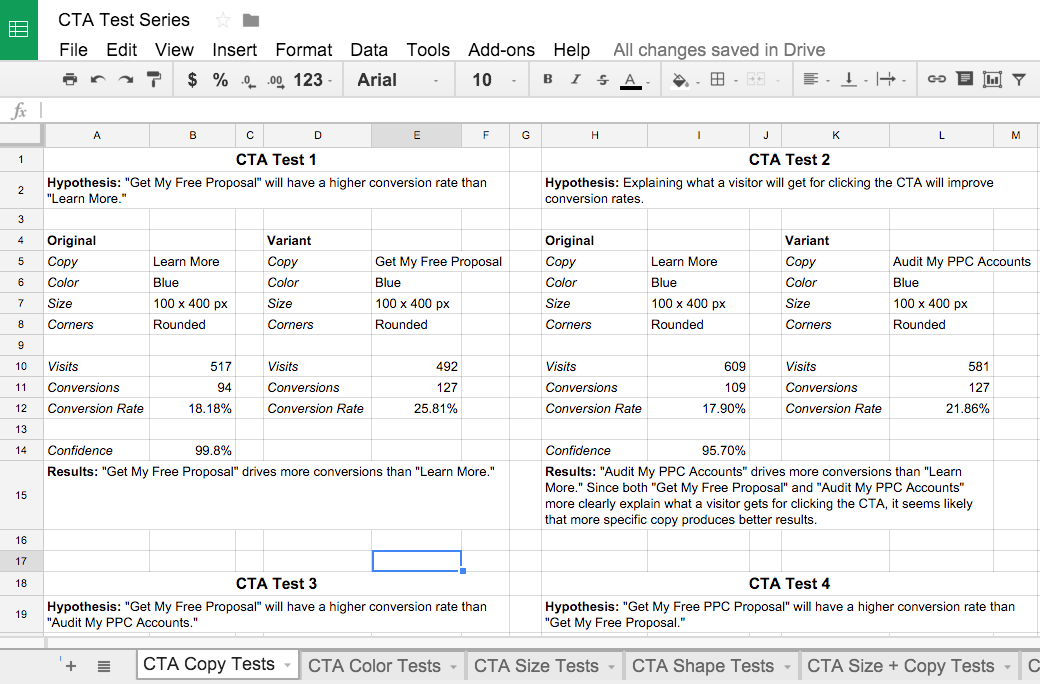
Now that you have an idea of what A/B testing is, how to approach it, and how to expand on your learnings – what will be your next (or first!) A/B test? Learn how Bluetext has helped clients achieve stronger KPIs and boost conversion rates through strategic A/B testing on our site.
Learn your customers. This is not news to anyone in sales, but the more you understand about your audience, the better you can appeal to them. With more and more sales moving to digital, companies need to invest in digital empathy and offering a personalized brand experience is the way to go. Gartner agrees, that this is the year that personalization can enable up to 15% more profits for companies who re-engineer their content strategy to align with customer intent on a case-by-case level. For instance, a questionnaire that simultaneously tracks their answers and interests while drawing them to your critical on-site content that aligns with those interests is a win-win. In the end, your customers are satisfied immediately when, after a few clicks, get what they need on a personalized listing page or action report, especially if you gate it, and you understand your customers in real-time. Raise your hand if you want to be a trusted consultant and thought leader with great top of funnel pipeline…
Peak Interest. Peak Opportunity.
You’re being overmarketed. That must sound strange coming from a marketing blog, but the truth as we see it is that there is more noise out there than ever and digital ad-apathy is stronger than it’s ever been. So how can marketers cut through that noise and get their foot in the door? Lead generation today is about taking the time to tailor and target the message to the right person. It’s important to balance marketing automation with personalized lead-by-lead outreach. Is it time-consuming? Absolutely. Is it worth it to increase your ROI? Absolutely.
Marketers overwhelmingly agree that personalization is a huge benefit for developing and maintaining customer relationships. According to Adobe 60% of us are having trouble trying to make the switch to personalized content, but 90% of marketers recognize that their target audiences expect a personalized experience.
So what change is happening to boost marketers’ confidence in 2020?
Empirical Empathy.
You may have the creative personalized ideas, writers, designers, and web developers ready to help go to market, but until your business has the right data to drive your GTM ideas, you might be starting from scratch. Instead, companies who cultivate all of their customer data together, including customer journey tracking, cross-platform reporting, and aggregating lead generation trends across their web, mobile, email, and social channels will find the personalized insights they need to succeed. Harness the bountiful (and cheap) organic user information, across multiple data platforms, into one cohesive customer profile. Then build your storytelling experience, quiz, or dynamic CTA button around what you’ve discovered about your users. Turn your expensive anonymous users into cheaper hyper-targeted users through a foundation of data and let a personalized marketing experience reap the benefits.
On average, marketers within companies store their customer data in at least four different systems, most of which are not shared or have no way to make meaningful connections. Dramatic investments are in store for whatever integration, platform, or process can unite the omnichannel user data and enhance data analysis. Start with implementing data-driven objectives like:
- Location Data
- Overlays
- Survey Responses
- Ad Campaign Interaction
- Tag and Filter Results
- Track Pageviews
- Smart Lists
- Dynamic Content Blocks
- Link Clicks
- Referral Source
With this precise user understanding at marketers’ fingertips, we enjoy the familiarity of personalized campaigns. Yet culling that data together and offering a message or experience to the potential lead based on their previous interactions with your company is vital to getting that foot in the door. Invest in understanding your audience and their behavior and interests and they will invest in understanding you.
Email is Still Mail.
Let’s face it, our inboxes aren’t overflowing with personal communications from friends and loved ones. That doesn’t mean email marketing has to be impersonal. So how do we get a user to click on that one email subject line when they return from vacation to a mailbox full of ads? Personalize your headline copy, customize imagery by location, gender, or season, and insert dynamic CTAs to make the offer relate to what you know about them. Make it pop!
Bonus – add additional personalized flair to your brand experience by implementing a kickback email upon conversion. The most common form of a kickback email is an automated thank you note sent to their inbox once their personal information enters your CRM. Higher engagement rate – check. Great first impression – check. Polite digital etiquette – check.
You’re on the Right Landing Page.
Let’s say you’ve finally convinced the user to engage with your content and click on the CTA button, you know you have their full attention. Making a personalized first impression when they arrive on the landing page both affirms that they are in the right place and encourages them to remain there. In the Calling All Optimists case study, the media campaign was designed to match the messaging that worked in the first place to pull double-duty by complementing the interest on the landing page. Driving the target audience to the site, the user is met with a unique welcome message in the hero-zone correlated to the specific ad they engaged with.
Personalizing your page ensures that traffic from all over the world sees the most appealing content for them. Whether it’s one of your homepages (yes – the more the merrier!) or a campaign landing page, every page should have a purpose correlating to every unique visitor and their previous exposure to your brand.
Make It Personal
Stand out by personalizing your digital reputation. Customers will remember your services, your messaging, and your products if you direct them to what makes sense for them, rather than sending them on a wild goose chase. Content marketing has been top of mind for this industry for years now, but personalizing that content marketing strategy is a way to make your brand feel exciting and special.
It’s time to say goodbye to cookie-cutter content passively thrown into your resources listing page and keeping your fingers crossed that someone stumbles into it. With social media engagement on the downfall and Google’s algorithm prioritizing their own thought leadership over yours, it is imperative to transform your strategy into something that appeals to your ideal customer. Two-thirds of consumers say they will switch to brands that treat them like an individual rather than a data point, a trend that will continue to be driven by younger audiences who value brands that are transparent, authentic, and personal.
No matter the tactic, the fundamental purpose of personalizing any campaign is to boost engagement by telling the user you understand their need. Communicating your own message by listening to their needs first will always prove to be worth the research, planning, and testing effort. Delighting the modern consumer is going to take some analytics-grit, but doing your marketing homework before investing in any large personalization initiative will pay off in 2020.
If you’re looking to digitally personalize your content, reach out to Bluetext to help you succeed.
The decades-long reign of the PC is over, with mobile devices now making up more than 52% of all internet traffic. While plenty of people preach the importance of responsive website design, far fewer have articulated updated guidelines for the reality of today’s internet. Keenly aware of trends as ever, Google has continually refined its search algorithm to keep pace with increasingly mobile and untethered internet. Advertisers, marketers, and website owners alike need to be aware of what these paradigm shifts are, and how that could impact their sites’ SEO.
Cellphones’ bountiful data has empowered Google to enhance its search engine. Search results are more custom than ever before, incorporating key differentiating factors like time of day, weather, and geography. The search results for a morning bagel in Washington D.C. will look entirely different three hours later in San Francisco.
Optimizing for Local Search
More so than ever before, websites need to be local. Gone are the days of simply tacking on addresses and list of phone lines. To be competitive in 2020, websites need to address the mindset and inquiries of the region they serve, be it a street, coast, or country. A quintessential, doughy foldable New York slice is in stark contrast to a dense, deep-dish pie from Chicago. The top result for a pizza in Manhattan will not be wasting content on merely their cheese, sauce, and pepperoni, but rather what distinguishes their slice from their other New York brethren. Language, context, and local distinctions are now a mandatory part of website content strategy.
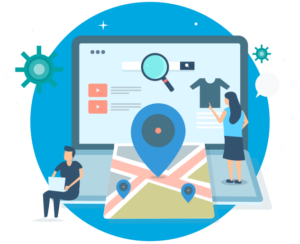
Dealing with Short Attention Spans
Major changes to search algorithms are only a handful of the changes introduced by the rise of mobile. Attention spans online are shorter than ever with the ubiquity of the internet and easily accessible information, even more so for mobile where screen size comes at a steep premium. Hero zones should be appropriately leveraged. Heroes should state the most important critical information concisely and contain a quick and simple CTA or takeaway. Organic visitors who cannot immediately find an answer to their search query after a glance and a few swipes will assuredly bounce away to a competitor.
Search and Virtual Assistants
Smartphones’ impact on websites has not just been limited to mobility and smaller screens. Virtual assistants like Amazon’s Alexa, Google Assistant, and Apple’s Siri fundamentally change how people browse the internet. For many on-the-go, the automated search functionality provided by these virtual assistants have all but replaced a typical Google search.
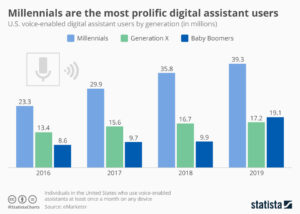
How Google and the other virtual assistants parse through webpages and present them for voice search is a complex topic, but the vital SEO fundamentals remain in place. Research demonstrates that people are unsurprisingly far more conversational in their wording versus a typed-in search. Optimized content thus needs to serve this need directly, often best served using blogs that cover such frequent, informal topics as “What is the best X” or “Y versus Z”.
Google has been increasingly leveraging its structured data for voice search results, largely due to its predictable format and parseable nature. For best results, website owners need to cross-reference website content and identify what data could be passed off to Google using structured data. Articles, menus, locations, events, and reviews are just a handful of the many structured data formats that Google accepts. Conveniently, Google now provides a simple tutorial for anybody familiar with HTML to get started on incorporating structured data and improving their site for voice search.
The shift to mobile devices has opened up new avenues for content creation and design. Location and voice were unheard of topics even a decade ago, but they are here to stay for organic search. It’s up to website owners and marketers whether they take advantage of these new strategies, or get left in the dust.
Programmatic Advertising – No Signs of Slowing Down in 2020
If you spend any time at all surfing the web, you have encountered some form of programmatic advertising. The video ad that plays before you stream your favorite TV show? Programmatic. The banner ad that appears alongside the cooking recipe you’re reading? Programmatic. The sponsored article content that shows up as you’re scanning your favorite news site? You guessed it – it’s programmatic.
Programmatic Advertising – What is it?
Programmatic ad buying is the use of software to purchase digital advertising in real-time, as opposed to the traditional ad buying process that involves RFPs, human negotiations, and manual insertion orders. It allows digital agencies like Bluetext to strategically select where we want to show display, video and native ads, and when.
A huge benefit of programmatic advertising is that the software grants advertisers access to the biggest data providers in the game. Not only are we choosing where and when to show ads online, but we have the capabilities to choose who actually sees our ads. Advertisers are able to hand-select from thousands of audience segments collected by these data providers and layer those segments onto programmatic campaigns.

Why Invest in Programmatic?
While targeting capabilities and ease-of-use are two major benefits of investing in programmatic advertising, there are a number of reasons why digital agencies should hop on the programmatic bandwagon in 2020.
Here are Bluetext’s top 3 reasons for investing in programmatic advertising in 2020:
1. Artificial Intelligence (AI) and Machine Learning
Programmatic advertising already makes digital ad buying easier for advertisers than it ever was before, but AI and machine learning have simplified the process even more. For years, media buyers and digital marketers relied on a manual process to review campaigns, manage budgets, make adjustments to ad creative, and more. However, AI and machine learning have become so sophisticated that the manual days of optimizing are nearly over. Once your campaign has launched, the AI will start to learn what’s working and what’s not, shifting budgets and making adjustments to enhance efficiency in real-time. Studies show that by 2035, AI will boost productivity and profitability by nearly 40%.
As a leading digital marketing agency, Bluetext has seen the benefits of AI and machine learning pay off in major ways. Not only is our digital marketing team more efficient, but the results we were able to drive for clients in 2019 far exceeded their goals. With AI and machine learning only becoming smarter, Bluetext is equipped to reach new heights with programmatic advertising in 2020.
2. Digital Out of Home (DOOH) Opportunities
Digital Out of Home (DOOH) advertising is a unique marketing channel that allows advertisers to reach users outside of their homes in digitally-displayed spaces. Though DOOH media isn’t new, it’s expected to grow exponentially in the coming years. Reports show that between 2016 and 2023, the DOOH media channel will grow from $3.6 Billion to $8.4 Billion.
With the average person spending 70% of their time outside of their home, investing in DOOH in 2020 is a no-brainer. From mobile geofencing to digital billboards, the opportunities to reach people on-the-go are vast. Most importantly, because DOOH is now offered through programmatic platforms, advertisers will have access to significantly more data from DOOH advertising than ever before.
Digital marketing agencies like Bluetext now have the ability to measure results from a digital billboard ad or an animated kiosk through the data and technology programmatic tools provide. Bluetext is looking forward to expanding DOOH capabilities in 2020 to connect the dots from in-home browsing to in-store purchasing.
3. Multi-Channel Advertising
In the past, advertising agencies had to leverage several different platforms, media vendors and direct buys to ensure they reached their audiences across all mediums. Programmatic advertising has simplified this process so that marketing agencies like Bluetext can execute all advertising efforts through one simple-to-use platform.
Programmatic solutions include paid social, display, video pre-roll, native advertising, geofencing, DOOH, connected TV and more. Digital marketing agencies like Bluetext now have the capability to run one digital campaign across all different mediums and – most importantly – track user behavior across all touchpoints. With AI and machine learning, programmatic campaigns will optimize to reach users at the right time on the right medium, whether that’s on the computer, on their smart TV, or in a store on their mobile device. In 2020, it’s expected that even more multi-channel solutions will be announced, such as voice-activated ads powered through devices like Alexa and Siri.

Programmatic advertising has opened the door for digital marketing agencies like Bluetext to effectively run and execute campaigns across a number of channels and mediums, making media dollars more efficient than ever before. With the expansion of programmatic solutions in 2020, there’s no limit to the number of possibilities Bluetext will be able to leverage to drive digital media success for our clients. To learn more about our work with programmatic advertising contact us.
Driving engagement and other key metrics through organic social media is often an important component of a marketing campaign that targets business executives as its target audience. It complements any paid social or media, helps build awareness, and motivates target audiences to click through to a website or other campaign assets.
The question is, how do you determine the best timing in order to get the best results? This is especially tricky, given the short shelf-life of a Tweet, a Facebook post, or a LinkedIn feed. There are many myths regarding when to post organic social to drive the best results for a marketing campaign. Most of them are based on old, out-of-date assumptions, or gut instinct. Bluetext decided to test these to get hard data behind our campaigns.
The Old Common Wisdom on Social
There are some older pieces of conventional wisdom that have become ingrained in practitioners and that date back a dozen or so years to when social media campaigns were relatively new. Here are a couple that seem to make sense, but that we thought might be outdated given today’s “always-on” business culture:
- Don’t post on Mondays or Fridays. On Mondays, people are busy getting ready for the week and are likely to miss the posts. On Fridays, people are leaving early or checking out for the weekend. And never expect them to engage over their busy weekends.
- Avoid first thing in the morning and late in the day. It’s better to try other times when your target market isn’t so busy or trying to clear out of the office to get home.
Why We Wanted to Test Those Assumptions
Ultimately, we weren’t convinced that the older conventional wisdom was still valid. People work more flexible hours now than previously and are on-line and multi-tasking on a regular basis. Here at Bluetext, we wanted to get real data for ourselves so we could make the best recommendations for our clients.
How We Designed the Test
Working with a large client whose target audiences include business executives in the retail space, Bluetext designed a test that would send out social posts across three platforms where the client has a significant presence and following:
We did this over a four-week period, sending out those posts at a different time of day each week. For Facebook and LinkedIn, we also send out posts on different days of the week to see if and how that might make a difference. We looked at re-posts, replies, likes and link clicks.
The Results
Contrary to the conventional wisdom, the best results for the test’s Tweets were for those posted at 9:00 am and pm weekdays, outperforming those sent at 8:00 am, noon, or mid-afternoon.

The best results for LinkedIn were for those posted at noon on Tuesdays and Thursdays but other positive results for 9:00 am on Wednesdays and Saturdays.
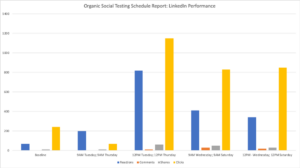
For Facebook, the best results came at noon on Tuesdays, Wednesdays, Thursdays & Saturdays.
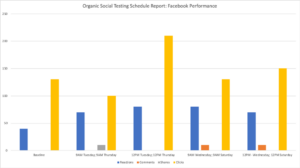
How to Leverage This New Data
Focus social posts around those best times and dates for each platform, but don’t ignore the other times or days of the week. Although posting content during “off-hours” might not deliver as much engagement, they will help to build awareness.
As marketing professionals improve at optimizing their advertising campaigns around personalized messaging and graphics for target audiences, a “Time Machine” strategy of targeting prospects will become more prominent in 2019.
What’s a Time Machine for marketing? It’s a new approach to targeting the best prospects based on what they might have done – or attended – in the past.
Tracking behavior via AI and advanced analytics of individuals who have attended an event in the past and targeting them for digital outreach offers a new avenue of personalized digital marketing. In one recent example, Bluetext identified everyone who has gone to see a sports team over the past year, with the intent of serving up ads for with offers to buy season tickets or branded merchandise. Only recently have the data analytics and AI been available that could identify who attended a game over the past year. That’s why we call it “Time Machine” technology.
Yet, Time Machine strategies don’t stop at just attendance. Personalization also means setting up a whole system of user personas, messages for each persona, and specific creative that will appeal to them. Then, if prospect (A) performs action (B), they receive item (C); while prospect (X) performing acting (B) will result in them receiving item (Z). So while two individual prospects may have both gone to the same game, getting them to buy the tickets for next season may require different messages to push them over the finish line. Tracking behavior via artificial intelligence and targeting audiences for digital outreach is just one of the ways that a “Time Machine” strategy leverages deep data as a new avenue of personalized digital marketing.
Personalization is powerful because it solves the problem of relevance. Traditionally, ads were targeted at mass audiences, meaning that the vast majority of impressions were useless because they were not relevant to the viewer. A Time Machine strategy, paired with a robust personalization system, means that you can deliver more relevant ads and, in turn, have a better chance of converting more prospects.
At the end of the day, a Time Machine strategy is all about increasing relevance by matching an individual’s past behavior with a message and/or creative that compels them to repeat that behavior. Your brand’s value proposition, communicated in the prospect’s language, matching their expectations, and addressing their unique needs and desires, will be more meaningful with a Time Machine strategy.
Learn how Bluetext can help you make the most of the top marketing trends for 2019.
Dynamic content may be the next big thing for digital marketers. In the marketing world, as personalization becomes more in demand, the power of artificial intelligence and data analytics to deliver personalization through dynamic content generation is taking on a larger role. That artificial intelligence is taking the guesswork out of marketing. No longer do digital marketers need to “hope” that, for example, a blue-themed campaign landing page with lots of large images or a certain type of blog post will appeal to all audiences. Artificial intelligence can provide real insights on messaging, graphics, color schemes, and even the types of content that marketers push out to target audiences.
This evolution may be closer than you think. In fact, according to eMarketer, forty percent of marketers in a recent survey responded that they were currently using AI to fuel their dynamic creative. That number was consistent with audience targeting and segmentation, creating a clear path to real personalization. This tactic has given advertisers the unparalleled ability to know their audience through identification, segmentation, and targeting.
Because various types of testing can be done now thanks to AI, marketers are able to find the optimal way to target a particular consumer. This includes elements such as colors, fonts, call to actions and images. Targeted advertisements not only serve a consumer the product they were looking at in the days or weeks before but in a way that would be most appealing to him or her, increasing the likelihood of engagement.
Beyond customizing the content that users are served, consumers are increasingly interested in curating their online experiences as well. That helps explain the endless number of social media platforms available to us.
We recently worked with the cognac company, Courvoisier, to launch their Honor Your Code campaign microsite which truly defines what we mean by “user-generated content.” The site encourages users to create a meme by uploading a photo, adding their hometown, and choosing a “code” that they respect and honor. Memes are then shared to social media, and ingested into the CMS by an Instagram API to display in a scrolling mosaic grid. Users are also able to explore the “Heatmap” by clicking on cities across the country to view other codes being shared and possibly even their own.
The Honor Your Code site on mobile provides for a unique user journey with more of a “native social” experience. Videos and Instagram posts display in a scrolling, digestible way users have become accustomed to. The site also features age authentication and a product locator.
It’s no question that people love personalized content. According to Janrain, 74 percent of online consumers get frustrated when content on the websites they visit has nothing to do with their interests. It’s clear that generating dynamic content for your audience is vital to a brand nowadays, so why not take a deeper dive into each individual’s profile to better understand what will work with that specific target audience? It is much more effective to serve content types and styles that the individual responds to instead of a blanket assumption of one-size-fits-all.
Learn how Bluetext can help you make the most of the top marketing trends for 2019.
Our association clients often ask us what our process is for developing digital campaigns that will deliver the best results, whether that’s awareness for their brand or attendance for their conferences and events. Top marketing firms understand that a strong, repeatable process is key to getting the right messages and creative to the right audiences at the right time. They also know that analyzing results on a continual basis is the only way to optimize performance by revising and adjusting when needed.
At Bluetext, we take a disciplined approach to every campaign, and that begins with discovery. We start by asking three questions:
- What is the goal of the campaign?
- Who are the target audiences?
- What do you want them to do?
These might sound like simple questions, but you might be surprised at the discussion that follows within the association world to get to an agreement on each of those. Top marketing firms like Bluetext know that we have to act as both a facilitator and as a honest broker who can push each stakeholder to reach that agreement. The reason is that at most membership and trade associations, there are different “clients” who have different goals for each campaign. In some cases, it might be membership renewal, while for others in the same organization it might be registration for an event that drives revenue. For others, it might be awareness of the services that the association provides.
But it’s not until that decision is made that we can move on to the next question: Who are you targeting? Again, that might sound simple, but we’ve witnessed our share of knock-down, dragged-out fights inside organizations where stakeholders have a different opinion of the audience. In some cases, part of the client team might be focused on entry-level IT professionals for their particular association, while their colleagues might believe that the true target is the mid-level professional seeking to move up in their career.
But the most difficult question seems to always come down to, What do you want them to do? The easiest response might be to do something that drives revenue, whether it is to become a member of the organization, or to renew their membership. It might also be to attend an event or purchase a service. But it might also be simple awareness of the value of the trade association and the services it brings to its members.
For each of these possible answers, there might be a multi-step process to take the action. We don’t expect, for example, a new prospect to commit to attending an annual conference just because they receive an email or see a banner ad or paid social post. It may take a sophisticated email “drip” campaign that methodically delivers different types of information that drives them down through the sales funnel before they click on a landing-page for registration. Each step of the process requires clear messaging and strong creative. And each step requires effective analytics to measure performance of the subject line (for an email) or headline (for a banner ad). We are always A/B testing subject and headlines to see which are performing the best so we can adjust accordingly.
Top marketing firms will provide detailed methodologies and analytic tools before the campaign is launched so that organizations understand exactly how the campaign will run and achieve the desired results.
